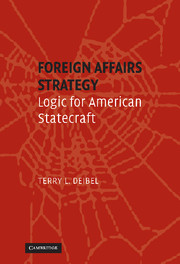Book contents
- Frontmatter
- Contents
- Preface and Acknowledgments
- 1 Introduction: Defining Strategy
- PART I ASSESS
- 2 The International Strategic Environment
- 3 The Domestic Context for Strategy
- PART II ANALYZE
- PART III PLAN
- APPENDIX A Definitions of Grand Strategy, National Security Strategy, and Statecraft
- APPENDIX B A Linear Design for Foreign Affairs Strategy
- Index
2 - The International Strategic Environment
Published online by Cambridge University Press: 05 June 2014
- Frontmatter
- Contents
- Preface and Acknowledgments
- 1 Introduction: Defining Strategy
- PART I ASSESS
- 2 The International Strategic Environment
- 3 The Domestic Context for Strategy
- PART II ANALYZE
- PART III PLAN
- APPENDIX A Definitions of Grand Strategy, National Security Strategy, and Statecraft
- APPENDIX B A Linear Design for Foreign Affairs Strategy
- Index
Summary
Successful strategy for foreign affairs ends – and therefore must begin – in the real world of international relations. If successful, it ends by influencing other global actors or changing the international environment in ways favorable to the nation's interests. To do so it must begin with an accurate mental picture of domestic and international reality, an understanding of the politics and economics of foreign policy at home and of how the world works abroad.
Such knowledge is not easily acquired. For most decision makers it is a product of years of experience and learning, heavily influenced by deeply ingrained habits of mind and by value preferences of which the individual may only be dimly aware. Much of the most useful knowledge relates to how other strategists are likely to think and react, demanding a kind of empathy with foreign mentalities and cultures that few Americans, at least, possess. During the months preceding the U.S. 2003 invasion of Iraq, for example, even Western observers with the most impressive experience of the Arab world and of Iraq itself were far from agreement as to how Saddam Hussein might respond to American pressures. When it comes to the broader vistas of foreign affairs strategy, “knowing” involves such a vast universe and comes at such remove from it in time, space, and cognition that the task may seem virtually beyond human capacity.
- Type
- Chapter
- Information
- Foreign Affairs StrategyLogic for American Statecraft, pp. 35 - 76Publisher: Cambridge University PressPrint publication year: 2007



